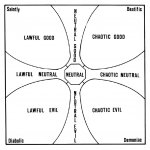This thread is pretty crazy. What it seems to indicate is up until 2000 D&D was pretty defined and most knew exactly what defined it.
However, now days, half the things people bring up is simply saying D&D=roleplaying and any time you play any roleplaying game it is D&D.
Another quarter on top of that (so around 75% of the stuff) describes other RPGs that do very similar things to D&D, but are different RPGs. (such as simply having 6 ability scores, or saves, or many other things other RPGs actually do possess)
Which seems to indicate that D&D has LOST a LOT Of what actually defines it differently from every other RPG out there.
And the only thing that makes D&D...D&D...is someone slapping the name D&D on a game system and declaring it such.
The rest DO cover things such as the specific six stats (other games have six ability scores, but D&D has specific ones, alignment and classes that require alignment such as the paladin...etc...etc...etc), and are specific enough that one could identify D&D from it.
As a result, scarily enough, I think this post in this thread actually describes how a LOT of people think of, define, and see D&D these days.
For me?
D&D is whatever the copy right owner says it is.
d&d is a generic name for a fantasy RPG with class and levels.
However, it seems a little crazy to see that people basically have a very generic view of D&D that could actually apply to other RPGs out there. It would indicate that even if they are playing another RPG, if asked what they are doing, they'd probably reply...playing D&D.
I guess it depends an where you were at then, because that wasn't my experience at all (I played 1e from 1981 to 2012). The only time you couldn't easily transition from one table to the next was when you had something like:
"Hey, this is Maximillion,my Irda paladin with 18/00 strength and a +8 special made holy avenger. He's the son of a god."
But as far as houserules? The only variation I really saw from group to group was preference for stat generation. Everything else was pretty much the same. Weapons v armor chart? Ignored. Start at max HP at level 1? about 75/25 split.
That's pretty much what I saw as well...and that's from travel all the way from California to Europe where I saw the similarities. I almost always could drop in a game where ever and basically know the rules from the get go and meld right in.
There were houserules, but nothing so drastic as to really make the game truly different, unsure where people get that idea these days that games were that drastically different. I didn't really see that back then
(and as per the post that this initially replied to that referred to level limits as a drastic change between tables, no, someone ruling that the are no level limits does NOT drastically change the game rules from one game to the next...that's ONE rule among many...if that gives a perspective of what I would consider a non-drastic change in rules and how easily it was to go from game to game).
Maybe 5E's popularity is just coincidence, but I think part of it is just the style of play that it evokes. So I understand the hesitance to change the basic mechanics of the game. If the formula works, there's not a lot of motivation to tweak it.
In any case put me on the side of most things are "good enough" and not sacred cows. Why change things that are not broken? There's a handful of things (I dislike how ability replacement items work) but those are easily house ruled.
I think I agree with the idea (didn't quote the full post, but what I quoted above). 5e is simple enough for people to get started on it easily and quickly, has basic rules that people can remember pretty much from the get go, and is easily modified or utilized to play the game that they want.
I think that all plays into the popularity of 5e and has made it perhaps the most popular version of the game (D&D) since AD&D and BECMI.




